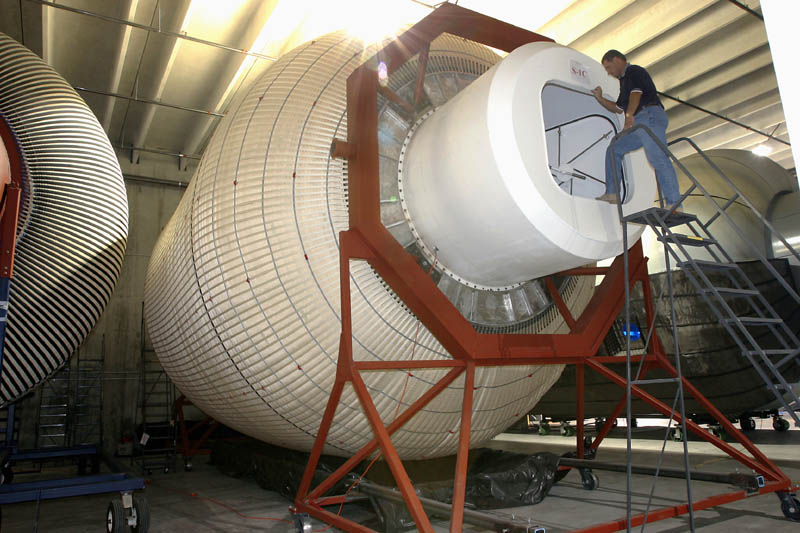
Inflatable space-station technology goes back quite a way, as it was researched by the Air Force as early as the 50’s. Since they missed out on the massive opportunity to use empty space-shuttle external fuel tanks as building blocks (I cry when I think of the wasted boosted mass) an inflatable station is our best bet.
A Russian rocket blasted off Wednesday carrying an experimental inflatable spacecraft for an American entrepreneur who dreams of some day building a commercial space station, officials said.
The Genesis I spacecraft lifted off from the southern Ural Mountains at 6:53 p.m. Moscow time aboard a converted Cold War ballistic missile, according to the Russian Strategic Missile Forces.
It reached its designated orbit about 320 miles above Earth minutes after liftoff.
The launch was a first for Bigelow Aerospace, founded by Las Vegas real estate mogul Robert Bigelow, who owns the Budget Suites of America hotel chain.
Very nice. I wish him success in this bold endeavor.















Yeee haaa. GO military space complex ! First they take our money and have us build a space station that they can not use, and then the gov teams up with private companies for this inflatable / cheap version. My suggestion is to strap all senators to the space station that does not work and send the station racing for the sun.
Maybe I’m reading a different article?
The whole point is that this is private and corporate money, isn’t it? I hope technology developed by NASA was available — as should happen with any taxpayer-funded research.
But, if this works out, if anything, it pokes a finger in the eye of overpriced NASA adventures. Especially those that many feel are nothing more than welfare programs for the military-industrial tortoises.
Bob Bigelow – space gigalo.
It had to be said.
Boosting the Shuttle’s external tanks (ETs) into orbit would take extra fuel, which the tanks themselves don’t carry. It’s not so easy to do, the more fuel you add, the more weight you have, the more fuel you need…
Also, it wouldn’t be so easy to join the ETs to create a space station. Working in space isn’t such a well developed art. Just notice how all components of all space stations until today have been built here on Earth and then *assembled* in orbit. Maybe it’s not such a brilliant idea to join ETs then open them up and make them habitable in orbit… Huge engineering work, all done in cumbersome space suits and zero gravity.
Maybe inflatable modules are a good idea, but I’m not yet convinced they could withstand the impact of micrometeorites or space junk.
The external tank is discarded right before orbital insertion, as it has to be attached until the main engines shut down.
I am not saying we could use them today, but you can’t deny that tons of material wouldn’t be useful at some point in the future.
I read a proposal years ago to attach a small solid rocket motor to the tanks to boost them into a more stable orbit. That was in the days when the shuttle fleet was going to be flying several times a month and paying for itself with commercial payloads. Governments will stifle entrepreneurial space programs. They don’t want to loose control, and there’s no difference between a vehicle capably of orbital insertion and an ICBM. The risk to payoff ratio is too great for corporate boards to swallow also. It’s too bad the human race is still so tribal that international cooperation just will not work.
Miguel,
Kevlar for the walls & they’d have better protection that the current space station, although it might be heavier than some light metal alloy.
Also they could boost up an impact shield to precede the station while it orbits. While not practical for a large structure, it would work for a smaller space station.
Both of these ideas were first put forth by Gerard K. O’Neill in the 70’s.
Just as in the early days of flight it will be the private ventures who will make things happen. The government cannot react fast enough to advances in metals, propulsion, computers, etc to take advantage, whereas the privately funded enterpreneurs can spin on a dime and go in whatever direction seems promising.
The biggest deterrent to space exploration is no one has hung a big enough carrot out there to entice the deep pockets into deep space.
NASA was never light, but it was arguably well managed during the Apollo years – remember they had huge problems right before Apollo, and it took some time for the whole Apollo program to start rolling almost withouth a hitch. However, after Apollo, NASA became a bureaucracy with no purpose. In that atmosphere careers take precedence over any ‘programs’ that might arise. To ‘help’ all that, budgets have been cut with no regard to the reality of how much it costs to send people and hardware into orbit. It’s hugely expensive, governments should invest *more* instead of saving, and while private initiative will have a word in lowering costs, don’t be fooled that we won’t see corners cut and people dying. It’s probably even more likely! At least NASA has always tried to be responsible and play safe – or at least NASA’s engineers and astronauts, I don’ really trust the bureaucrats who run the agency now…
I applaud the entry of the private sector into space exploration, but so many previous initiatives failed because of cost, risk, and the technology being too complex and generally ‘not there yet’. Rutan did a nice job, and is involved in some very state-of-the-art high tech research, but he’s far from orbit, and I doubt he can get there in his lifetime…